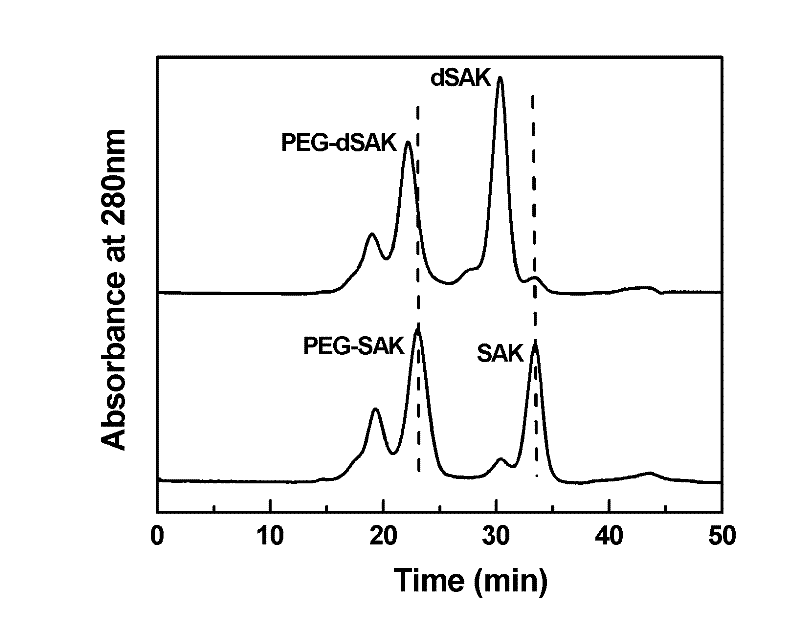Preparation method of recombinant staphylokinase dimer and site-specific modificaton of polyethylene glycol
A staphylokinase dimer, staphylokinase technology, applied in the field of protein chemistry, can solve the problems of staphylokinase biological activity reduction, staphylokinase activity reduction, interference with staphylokinase plasminogen interaction, etc.
- Summary
- Abstract
- Description
- Claims
- Application Information
AI Technical Summary
Problems solved by technology
Method used
Image
Examples
Embodiment 1
[0033] Example 1 Construction, expression and purification of recombinant staphylokinase (SAK) containing cysteine at the C-terminus
[0034] 1 Experimental method
[0035] 1.1 Construction of recombinant staphylokinase (SAK) gene
[0036] Design and synthesize the following 2 primers:
[0037] Primer (pF) sequence: 5'-atgcccatgggcaaaggcgatgacgcg-3'
[0038] Antisense primer (pR) sequence: 5'-gctaggatccttagcagccacctttcttttctataacaacctttgta-3'
[0039] Using SakSTAR as a template, -Gly-Gly-Cys was introduced into the C-terminus by PCR method to construct recombinant staphylokinase. The denaturation, annealing, and extension temperatures of a single cycle of PCR were 94°C, 55°C, and 72°C, respectively, and the reaction time for each temperature was 30 seconds. Perform 30 cycles to obtain PCR amplification products.
[0040] 1.2 Construction of recombinant staphylokinase expression vector
[0041] NcoI / BamHI double enzyme digestion reaction system was used to digest the gen...
Embodiment 2
[0049] Example 2 PEG site-directed modification and product identification of recombinant staphylokinase dimer
[0050] 1 Experimental method
[0051] 1.1 Dimerization reaction of staphylokinase with different ratios of 1,4-bismaleimidobutane
[0052] 1,4-Bismaleimidobutane (BMB) was dissolved in N,N-dimethylformamide to prepare a solution with a concentration of 4mM. The concentration of the purified staphylokinase is 0.2-0.3mM, and the buffer system used is 20mM phosphate buffer (pH 7.4). Staphylokinase and BMB were reacted overnight at 4°C at 1:0.5, 1:1, 1:2 and 1:5 (molar ratio), and the obtained products were identified by Superdex 200 gel filtration column.
[0053] 1.2 PEG-aldehyde (20K) site-directed modification of staphylokinase and its dimer (dSAK)
[0054] The reaction buffer system was 20 mM acetic acid-sodium acetate buffer (pH 5.0). SAK:PEG:NaCNBH 3 = 1:6:60, dSAK:PEG:NaCNBH 3 =1:8:80. The final reaction concentration of staphylokinase was 0.1 mM, and the...
Embodiment 3
[0064] In vitro activity assay of embodiment three PEG-modified staphylokinase dimer (PEG-dSAK)
[0065] 1 Experimental method
[0066] The in vitro activity of staphylokinase was accomplished by the lysosomal circle assay. The buffer used in the experiment was 50 mM Tris-hydrochloric acid buffer (pH 7.5) containing 0.15 M NaCl. Weigh 0.1 g of human fibrinogen, dissolve it in 10 ml of the above buffer solution, and place it in a thermostat at 37° C. for 1 hour to fully dissolve it. Weigh 0.15 g of agarose, dissolve it in 10 ml of the above buffer solution, dissolve it with a microwave, and store it at 55° C. for 20 minutes. Add 10 U of thrombin into the completely dissolved fibrinogen solution, mix well and pour into the agarose solution, mix well and pour the plate. Leave the plate for 10 minutes to fully solidify, and punch holes on the plate. Add an equal amount of staphylokinase sample (0.2 mg / ml×20 μl) to each well, invert at 37° C. for 20 hours, observe the fibrinoly...
PUM
| Property | Measurement | Unit |
|---|---|---|
| molecular weight | aaaaa | aaaaa |
| molecular weight | aaaaa | aaaaa |
| molecular weight | aaaaa | aaaaa |
Abstract
Description
Claims
Application Information
 Login to View More
Login to View More - R&D
- Intellectual Property
- Life Sciences
- Materials
- Tech Scout
- Unparalleled Data Quality
- Higher Quality Content
- 60% Fewer Hallucinations
Browse by: Latest US Patents, China's latest patents, Technical Efficacy Thesaurus, Application Domain, Technology Topic, Popular Technical Reports.
© 2025 PatSnap. All rights reserved.Legal|Privacy policy|Modern Slavery Act Transparency Statement|Sitemap|About US| Contact US: help@patsnap.com



